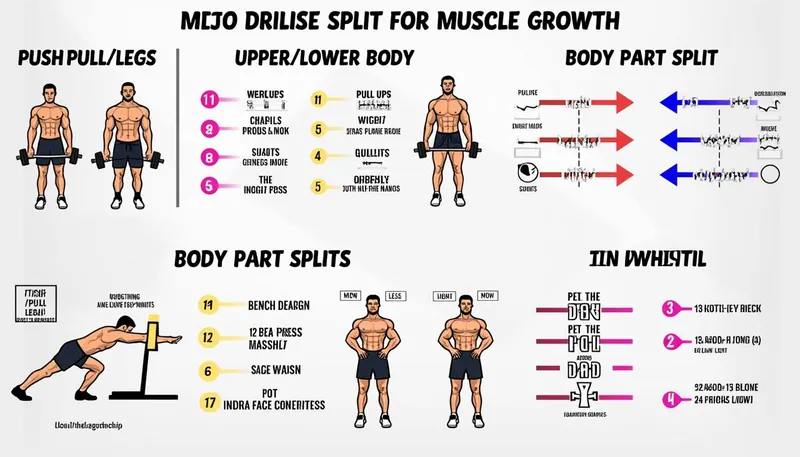When it comes to muscle growth, the structure of your workout routine plays a vital role. It’s not merely about what exercises you’re doing, but how you organize those workouts across the week. The concept of a workout split involves dividing your training sessions in a way that enhances recovery and stimulates maximum muscle hypertrophy. As fitness enthusiasts continue to discover new training methodologies, the conversation about the best workout split for muscle growth becomes increasingly prominent. The right split can significantly influence your progress in the gym, either accelerating gains or leading to plateaus.
With various options like the Bro Split, Push/Pull/Legs, and Full Body workouts on the table, choosing the right split can be overwhelming. Each approach has its nuances, providing different benefits depending on the athlete’s experience level and training goals. The evolution of workout splits reflects broader trends in exercise science, providing insights from decades of practice. As you explore these splits, think about your unique needs: how often can you train? What are your specific muscle growth targets? The answer to these questions will guide you toward an optimal workout plan.
- 💪 Training frequency is crucial: Hitting muscles several times a week can lead to better results.
- ⚖️ Balance is key: Ensure you’re not overloading your workouts or undertraining.
- 🛌 Recovery matters: Listen to your body and adjust your split accordingly.
- 📅 Keep it simple: A complex split can lead to wasted effort; focus on what works.
- 🔄 Flexibility is important: Adapt your training scheme to fit your schedule.
Understanding Different Workout Splits for Muscle Growth
In the pursuit of muscle gain, there are multiple methods to structure your workout routine. Let’s break down some of the most popular splits used by athletes and bodybuilders, focusing on how each one can help you reach your goals.

The Classic Bro Split
The Bro Split, often a favorite among bodybuilders, involves targeting one muscle group per workout. For instance, you might train chest on Monday, back on Tuesday, and legs on Wednesday, taking the rest of the week for other muscle groups. This approach allows for significant volume on each individual muscle group, which can contribute to serious hypertrophy. However, there’s a drawback: only training a muscle group once a week can lead to missed opportunities for growth.
Here’s why the Bro Split appeals to many lifters:
- 📈 High volume per muscle group: With multiple exercises hitting the target muscle group, you can truly exhaust it.
- 🔄 Recovery time: Allowing seven days for recovery helps the muscle rebuild stronger.
- 🤩 Simplicity: Easy to follow for beginners who can benefit from isolation exercises.
Push/Pull/Legs Split Explained
The Push/Pull/Legs (PPL) split breaks down training into three distinct categories: pushing movements (chest, shoulders, triceps), pulling movements (back, biceps), and legs. This method can be cycled in various ways but typically involves training each section twice a week. For example, a typical week may look like this:
| Day | Workout |
|---|---|
| Day 1 | Push |
| Day 2 | Pull |
| Day 3 | Legs |
| Day 4 | Rest |
| Day 5 | Push |
| Day 6 | Pull |
| Day 7 | Legs |
The PPL split brings several advantages:
- 🔁 Higher training frequency: Each muscle group is trained more than once a week, stimulating growth.
- 🕒 Flexibility: Training days can easily be adjusted to fit your schedule.
- 🧘♂️ Balanced recovery: Adequate rest periods are built into the routine, which is essential for muscle repair.
Full Body Training Split
Full body routines train all major muscle groups in every workout, typically occurring three times a week. This approach is ideal for beginners, time-constrained individuals, or anyone wanting to maximize frequency. By engaging every muscle group in one session, lifters can effectively promote muscle activation and growth using compound movements like squats, deadlifts, and bench presses.
Key points about full body training include:
- 💯 Total body engagement: Promotes balanced muscle development and keeps workouts fresh.
- ⏳ Time-efficient: Perfect for busy schedules since fewer training days are needed.
- 🛠️ Versatility: Allows for the inclusion of diverse training styles and variations.
Upper/Lower Split for Balanced Growth
The Upper/Lower split alternates between upper body and lower body workouts, often spread across four days a week. For example:
| Day | Workout |
|---|---|
| Day 1 | Upper Body |
| Day 2 | Lower Body |
| Day 3 | Rest |
| Day 4 | Upper Body |
| Day 5 | Lower Body |
| Day 6-7 | Rest or Active Recovery |
This method often prioritizes both compound and isolation movements, making it a favorite for those looking to balance strength and hypertrophy. Notable features of the Upper/Lower split include:
- ⚖️ Balanced focus: Each muscle group receives appropriate attention while preventing overtraining.
- 🔄 Flexibility: Easily adjustable based on energy levels or schedule.
- 🏋️ Variety: Offers a mix of movement patterns, stimulating growth overall.
Key Considerations for Selecting a Workout Split
Choosing the right workout split is crucial, yet there are several factors to consider. Understanding your goals—whether for muscle hypertrophy, strength, or endurance—will significantly shape your decision-making process. Here are some essential aspects to keep in mind:
- ⌛ Training Frequency: Aim for a plan that enables you to train each muscle group 2-3 times per week for optimal growth.
- 🛌 Recovery Needs: Be mindful of how your body feels post-workout; adjust intensity and volume based on recovery.
- 💡 Simplicity vs. Complexity: The best split often balances complexity with effective structures that you can consistently follow.
- 📈 Volume and Intensity: Ensure you’re fit for the workload—don’t push beyond your limits, causing burnout.
- 🌱 Personalization: Tailor your split according to your unique lifestyle and preferences for the best results.
Monitoring Progress and Adjustments
Your initial split may serve you well at first, but it’s vital to monitor your performance and adjust your approach as you grow stronger. As progress curtails, consider changing your split or incorporating new exercises. Additionally, ensure you’re periodizing your workouts—this can prevent plateaus and keep you motivated.
Frequently Asked Questions
What is the best workout split for muscle growth?
The best workout split greatly depends on your specific goals and how well it fits into your training schedule. Options like Push/Pull/Legs and Upper/Lower splits are popular choices among those aiming for muscle growth.
How often should I train each muscle group?
To optimize muscle growth, it’s commonly recommended to train each muscle group 2-3 times per week. This frequency facilitates both adequate stimulus and recovery for effective gains.
Is the Bro Split effective for hypertrophy?
Yes, while traditional, the Bro Split can effectively lead to hypertrophy if performed with sufficient volume and intensity. However, many find higher frequencies through other splits yield better results.
Can beginners use split routines?
Absolutely! Beginners can benefit from split routines; however, starting with a Full Body workout may be more advantageous to learn basic movements and ensure balanced growth.
What should I focus on when designing my workout split?
Focus on your training frequency, volume, and recovery needs. Choose a split that aligns with your goals and that you can sustain consistently to ensure long-term success.


